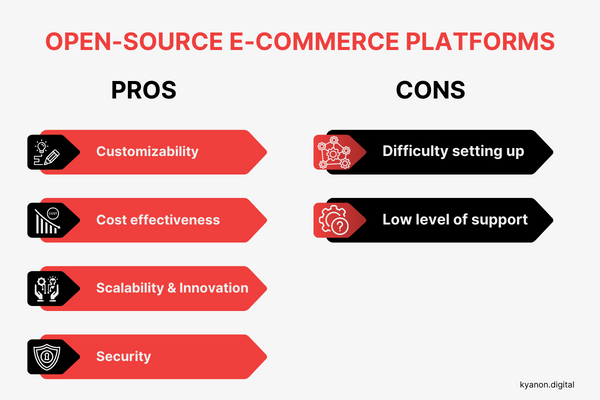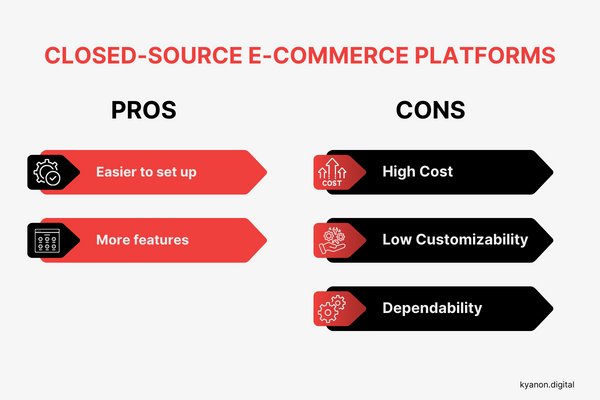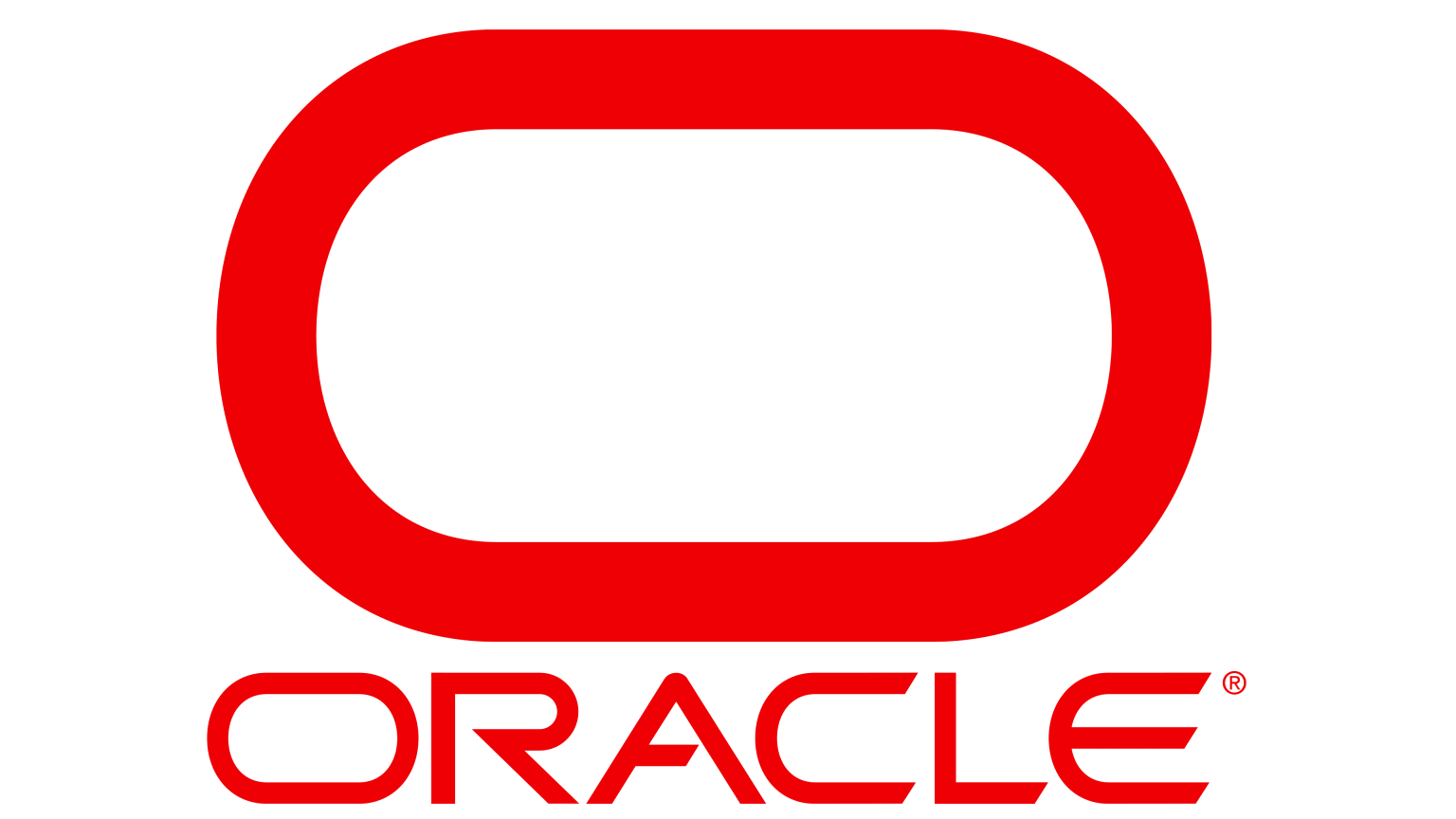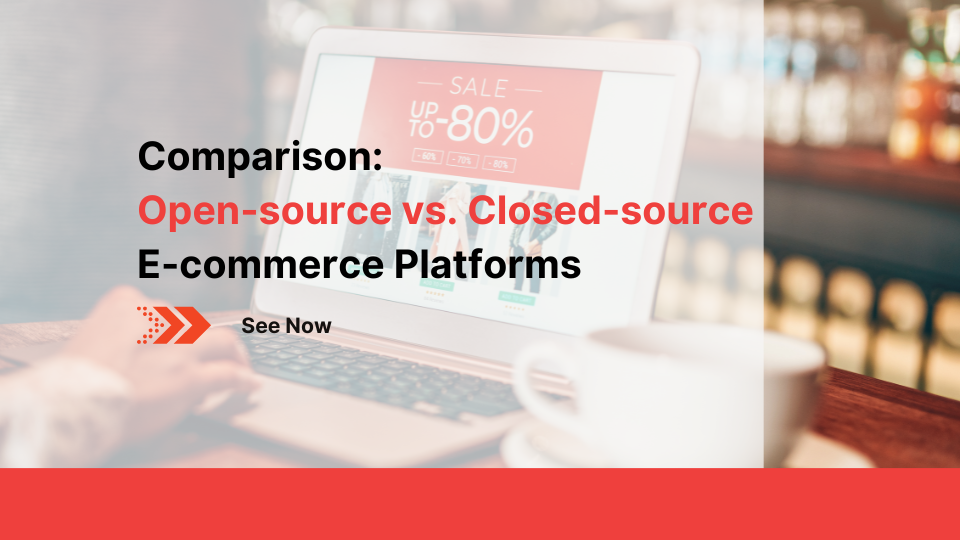In today’s business landscape, e-commerce has become a vital aspect for the growth and success of any company looking to increase sales. As you look to invest more into digital, choosing the right platform is the first and foremost element you need for the success of your online business. One of the important decisions you’ll face is whether to go with an open-source or closed-source platform. It’s important to carefully weigh the pros and cons of each option before making a decision that aligns with your company’s goals and needs.
In this blog, Kyanon Digital will walk you through the comparison between the Open-source vs Closed-source E-commerce platforms for all the medium and large companies to have a clear understanding which one is better for your business.
1. What is an Open-Source Platform?
Open-source platforms are software programs that are freely available for anyone to use, modify, and distribute. These platforms are often developed by a community of contributors who work together to improve software and fix bugs. Some popular open-source platforms include WordPress, Drupal, WooCommerce and Magento.

1.1. Advantages of Open-Source Platforms
Customizability
One of the biggest advantages of open-source platforms is that they are highly customizable. Because the source code is freely available, developers can modify the software to fit their specific needs. This means that businesses can create a platform that is perfectly tailored to their unique requirements.
Cost effectiveness
Another advantage of open-source platforms is that they are often more affordable than closed-source alternatives. Because the software is free, businesses can save money on licensing fees and other costs associated with proprietary software, like costs of maintenance, update, upgrade, etc. Owning an open-source solution is far more easy to budget and to be forecasted.
Scalability & Innovation
Open-source platforms are contributed by a community of engineers worldwide, allowing businesses several advantages such as easily adding new features with ready-to-use plugins, innovation following industry needs, frequent improvements and enhancements, easy integration with third-party systems, full control over data, and flexibility in hosting options. With open-source platforms, businesses can be confident that they have a reliable, customizable, and cost-effective solution for their operations.
Security
Finally, open-source platforms are generally more secure than closed-source alternatives. Because the source code is available for anyone to review, security vulnerabilities can be identified and addressed more quickly.
1.2. Disadvantages of Open-Source Platforms
Difficulty setting up
One of the main disadvantages of open-source platforms is that they can be more difficult to set up and maintain than closed-source alternatives. Because the software is highly customizable, it can take more time and effort to get everything up and running smoothly.
Low level of support
Another potential disadvantage of open-source platforms is that they may not offer the same level of support as closed-source alternatives. Because there is no central company responsible for the software, businesses may need to rely on community forums or third-party support services for help.
1.3. Examples of Open-Source Platforms
Magento: Magento is an open-source e-commerce platform that allows businesses to create online stores. The platform offers a wide range of features, including inventory management, payment processing, and shipping options.

WooCommerce: WooCommerce is a plugin for WordPress, making it easy to set up an online store and customize it to meet specific needs. With its ease of use, flexibility, and scalability, WooCommerce is a reliable and cost-effective solution for businesses looking to establish an online presence and grow their operations.

Drupal: Drupal is an open-source content management system that is often used for large-scale websites and applications. The platform offers a high degree of flexibility and customization, making it a popular choice for businesses with complex requirements.

2. What is a Closed-Source Platform?
Closed-source platforms are software programs that are owned and developed by a single company. These platforms are typically more expensive than open-source alternatives, but they may offer additional features and support.

2.1. Advantages of Closed-Source Platforms
Easier to set up
One of the main advantages of closed-source platforms is that they are often easier to set up and maintain than open-source alternatives. Because the software is developed by a single company, there is often a dedicated team responsible for ensuring that everything runs smoothly.
More features
Another advantage of closed-source platforms is that they may offer more features and functionality than open-source alternatives. Because the company has control over the source code, they can add new features and tools as needed.
2.2. Disadvantages of Closed-Source Platforms
High cost
One of the main disadvantages of closed-source platforms is that they can be more expensive than open-source alternatives. Because businesses need to pay licensing fees and other costs associated with proprietary software, it can be more difficult to justify the expense.
Low customizability
Another potential disadvantage of closed-source platforms is that they may not be as customizable as open-source alternatives. Because the source code is not freely available, businesses may be limited in their ability to modify the software to fit their specific needs.
Dependability
One disadvantage of closed-source platforms is vendor lock-in. If a business decides to switch providers, they may face significant challenges. Since the source code is not available, the new developer would have to start over again, causing delays and additional costs. This can be a major drawback for businesses that need to remain agile and flexible in a rapidly changing market.
2.3. Examples of Closed-Source Platforms
Salesforce: Salesforce is a closed-source customer relationship management (CRM) platform that is widely used by businesses of all sizes. The platform offers a range of features, including sales automation, marketing automation, and customer service tools.

Oracle: Oracle is a closed-source database management system that is used by many large businesses and organizations. The platform offers advanced features such as data warehousing, analytics, and security.

Adobe Creative Cloud: Adobe Creative Cloud is a closed-source suite of software tools that is used by designers and creatives. The suite includes popular programs such as Photoshop, Illustrator, and InDesign.

3. Why Medium and Large Enterprises Invest in Open-Source Platforms?
For medium and large companies, sustainability is key and open-source platforms can offer significant benefits over closed-source alternatives in the long run. Here are some reasons why:

3.1. Cost saving
One of the biggest advantages of using open-source platforms is that they are often more affordable than closed-source alternatives. Because the software is free, businesses can save money on licensing fees and other costs associated with proprietary software. This can be especially important for medium to large companies that may have limited budgets for E-commerce.
3.2. Customization
Another advantage of using open-source platforms is that they are highly customizable. Because the source code is freely available, developers can modify the software to fit their specific needs. This means that businesses can create a platform that is perfectly tailored to their unique requirements.
3.3. Security
Open-source platforms are generally more secure than closed-source alternatives. Because the source code is available for anyone to review, security vulnerabilities can be identified and addressed more quickly. This means that businesses can have greater confidence in the security of their platform.
Examples of Medium and Large Companies Using Open-Source Platforms
- Zappos: Zappos is an online shoe and clothing retailer that uses Magento as its e-commerce platform.
- The Economist: The Economist uses WordPress as its content management system to create and manage its website.
- Tesla: Tesla uses Drupal as its content management system to power its website.
When it comes to choosing a platform for your medium-sized business, there are pros and cons to both open-source and closed-source options. However, for many medium and large companies finding themselves at the start of digital transformation and looking to expand their E-commerce channels, open-source platforms offer significant advantages over their closed-source counterparts. By evaluating your company’s specific needs and requirements, you can make an informed decision about which type of platform is right for you.
Teams at Kyanon Digital have 10+ years of experience in digital transformation and agile engineering, especially in e-commerce and retail solutions. To get consultancy from experts in the e-commerce industry, please contact us for more information.


